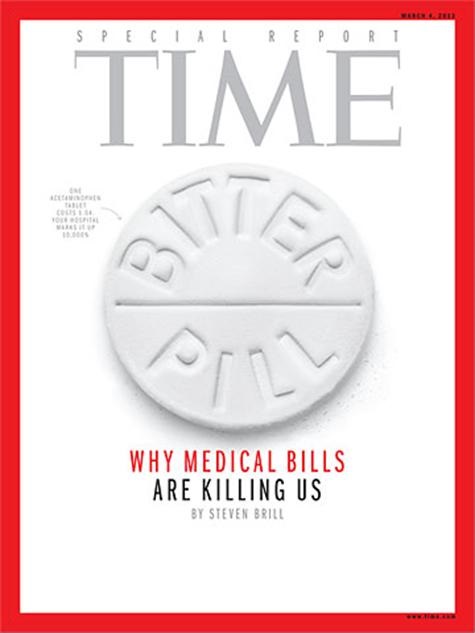Brill S. Bitter Pill: Why Medical Bills Are Killing Us. Time. February 20, 2013. PDF available at: http://livingwithmcl.com/BitterPill.pdf (accessed 4/2/13).

Editor’s Note: We had a special journal club in March. First, we reviewed an article from Time magazine rather than a traditional medical journal. Second, Paul Stander MD, the chief medical officer at Banner Good Samaritan Regional Medical Center, led the discussion and agreed to author the journal club. This seemed appropriate since much of the article focuses on overbilling and administrative costs of care.
The recent lengthy cover story article in Time Magazine described in great deal what many of us practicing physicians have realized for a long time – our health care system is highly dysfunctional and much of that dysfunction is a result of an arcane and outmoded financing mechanism. This payment system has a litany of perverse incentives that encourage wasteful and often ineffective care while not compensating for necessary, but less glamorous services, while simultaneously doing so at exorbitant cost that has created for us a competitive disadvantage in the world marketplace, contributed mightily to our federal budget deficit and led thousands of hardworking citizens to financial hardship or bankruptcy. The major points of the article were the following:
- Hospital pricing and charging mechanisms have no real relationship to true costs. This system is a result of decades long price increases that began in the era when hospitals were paid as a percentage of their charges. These charges for the most part do not currently reflect what hospitals are compensated by insurance companies or the government who pay fixed amounts based on case or per diem rates. Unfortunately the only people who may pay these inflated prices are those who are least capable of doing so - uninsured individuals who can then be financially devastated.
- Pharmaceutical and device manufacturers are paid far higher fees for their products in the United States than anywhere else in the world for no real justifiable reason which contributes to the disparate cost of care in this country compared to others
- Not-for-profit hospitals often make very high profit margins and have highly paid executives raising serious questions about the fairness of their tax exempt status and whether they truly fulfill their supposed community mission and whether they are truly providing adequate care for indigent and uninsured populations.
- The Affordable Care Act only partially addresses some of these issues – it really is designed to bring a lot more people into this-pro dysfunctional system, many of whom will be covered by government payments. While this will protect more patients from financial ruin, but it does little to address the other issues described above.
Real reform to our healthcare system will come only when we change the focus of the care we provide – particularly on the growing number of elderly patients with multiple chronic conditions who are the drivers of our ever increasing costs for Medicare and we also change the perverse incentives in our system that encourage waste and spending on ineffective or even harmful interventions. These reforms must be driven by clinicians in order for them to succeed.
Paul Stander MD
Chief Medical Officer
Banner Good Samaritan Regional Medical Center
Reference as: Stander P. March 2013 critical care journal club. Southwest J Pulm Crit Care. 2013;6(4):168-9. PDF